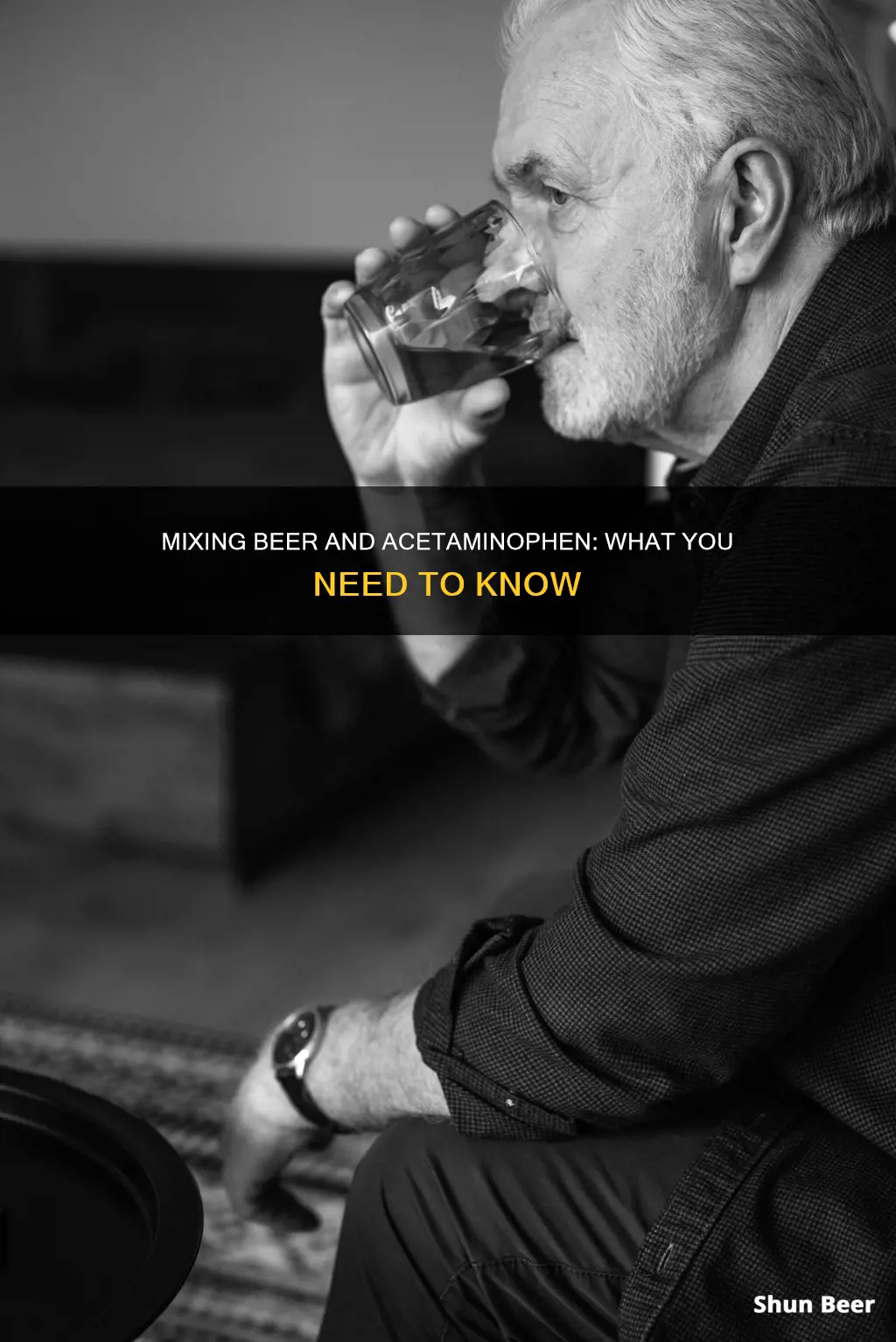
Tylenol (acetaminophen) is a medication used to treat mild-to-moderate pain and reduce fevers. It is available over the counter and is one of the most common drug ingredients in America. While it is generally considered safe to take acetaminophen while drinking alcohol in moderation, combining the two can have adverse effects on the liver and stomach. Both substances are metabolized in the liver, and when taken together, they can overwhelm the organ, leading to toxicity and potential liver damage. Additionally, mixing acetaminophen and alcohol can irritate the stomach, causing gastritis, ulcers, and internal bleeding. Therefore, it is recommended to avoid mixing the two when possible, especially if one engages in heavy drinking or binge drinking.
| Characteristics | Values |
|---|---|
| Is it safe to drink beer after acetaminophen? | Generally not recommended, but considered safe in moderation. |
| Recommended maximum daily dose of acetaminophen | 3,000 mg or 4,000 mg |
| Safe dose of acetaminophen over a four-to-six-hour period | 650-1,000 mg |
| Safe amount of alcohol after acetaminophen | Up to two drinks for men or one for women |
| Wait time after acetaminophen to consume alcohol | 4 to 24 hours |
| Side effects of mixing acetaminophen and alcohol | Stomach irritation, internal bleeding, ulcers, liver damage, rapid heartbeat |
| Signs of liver damage | Yellowing of skin or eyes, abdominal pain and swelling, unusual bruising or bleeding, confusion, fatigue |
What You'll Learn
- Acetaminophen and alcohol can irritate the stomach and cause internal bleeding
- Acetaminophen toxicity can lead to liver damage
- Alcohol and acetaminophen can cause nausea and vomiting
- Acetaminophen is an ingredient in over 600 over-the-counter medications
- Acetaminophen and alcohol can cause abdominal pain and swelling

Acetaminophen and alcohol can irritate the stomach and cause internal bleeding
Combining acetaminophen and alcohol can irritate the stomach and, in severe cases, cause internal bleeding. This is because both substances are metabolized by the liver. When alcohol is in the picture, the body produces more of the toxin NAPQI, which can be harmful to the liver in large amounts. Alcohol also decreases the production of glutathione, an antioxidant that helps to remove NAPQI from the body. As a result, NAPQI is more likely to build up in the liver in dangerous concentrations, leading to liver damage.
In addition to liver damage, mixing acetaminophen and alcohol can also increase the risk of stomach ulcers and internal bleeding. This is because alcohol can irritate the stomach and increase the toxicity of acetaminophen. Alcohol can also impair the liver's ability to break down acetaminophen, leading to a buildup of the drug in the body. This can result in acetaminophen toxicity, which can cause serious side effects, including liver failure, kidney failure, and inflammation of the pancreas.
The risk of negative side effects from mixing acetaminophen and alcohol is higher for people who regularly drink alcohol or take high doses of acetaminophen. Chronic, heavy alcohol intake can deplete the liver's stores of glutathione, making it more difficult for the liver to process acetaminophen. Additionally, repeated daily doses of acetaminophen can make the liver more susceptible to acetaminophen toxicity, even in people who only drink moderately.
To reduce the risk of internal bleeding and other side effects, it is important to avoid mixing acetaminophen and alcohol. If you need to take acetaminophen after drinking, it is generally safe to have up to two drinks for men or one drink for women before taking the medication. However, it is best to wait until the effects of alcohol have worn off, usually after 24 hours, before taking acetaminophen.
It is also important to consider your current health conditions and medications before mixing acetaminophen and alcohol. If you have a history of liver disease or alcohol use disorder, it is not recommended to mix the two substances. Additionally, many medications contain acetaminophen, so it is important to check the labels of your medications to avoid accidental overdoses.
The Magic of Appearing Beer: Trick Explained
You may want to see also

Acetaminophen toxicity can lead to liver damage
Acetaminophen toxicity is the most common cause of acute liver failure in the US, accounting for around 56,000 hospital visits per year. It is also the second most common cause of liver transplantation worldwide.
The risk of acetaminophen-induced liver damage is higher for individuals with alcohol use disorder (AUD) who also overdose on acetaminophen. However, there is no scientific evidence that people with AUD who take the recommended dose of acetaminophen increase their risk of liver damage.
To reduce the risk of liver damage, it is important to take no more than the maximum daily dose of 3,000 mg of acetaminophen for adults. Symptoms of liver damage include jaundice, pain in the upper right side of the abdomen or below the ribcage, swelling of the abdomen, and unusual bruising or bleeding of the skin.
Mixing Beer and Tylenol: Is it Safe?
You may want to see also

Alcohol and acetaminophen can cause nausea and vomiting
Combining alcohol and acetaminophen can irritate the stomach and cause nausea and vomiting. In more severe cases, it can lead to bleeding ulcers in the stomach or intestines.
Acetaminophen is metabolized in two ways. The body processes around 90% of the drug through glucuronidation, which does not produce any dangerous byproducts. The remaining 5-10% is broken down by the CYP2E1 liver enzyme, producing a toxin called NAPQI. To neutralize this, the liver produces an antioxidant called glutathione.
When alcohol is introduced, it increases the activity of CYP2E1, leading to higher production of the NAPQI toxin. Simultaneously, alcohol decreases the production of glutathione, causing a buildup of NAPQI in the liver. This accumulation can result in acetaminophen toxicity, leading to liver damage, failure, and even death in severe cases.
To minimize the risk of adverse effects, it is recommended to limit alcohol consumption to moderate levels and follow the recommended dosage for acetaminophen. For adults, the maximum daily dose is 3,000 mg, with 650-1,000 mg every 4-6 hours. It is also crucial to check the ingredients of other medications to avoid accidental acetaminophen overdose.
Beer and Tramadol: A Risky Mix?
You may want to see also

Acetaminophen is an ingredient in over 600 over-the-counter medications
Acetaminophen is a common ingredient in over-the-counter medications, featuring in over 600 different products. It is used to treat mild-to-moderate pain and reduce fevers. It is often combined with other medications, making accidental overdoses a possibility. It is important to always check the ingredients of over-the-counter medications to ensure you are not taking too much acetaminophen.
Acetaminophen is frequently combined with other medications, such as codeine, oxycodone, and hydrocodone. It is also found in many over-the-counter combination drugs, including Actifed, Alka-Seltzer Plus Liquid Gels, and Nyquil, to name a few. These combinations can be dangerous if not taken as directed, as they may contain higher doses of acetaminophen than recommended.
When taking acetaminophen, it is crucial to follow the dosing instructions carefully. For adults and teenagers, the recommended maximum dose is 1000 milligrams (mg) at one time or 4000 mg in 24 hours. Exceeding this amount can lead to an overdose, which can cause severe liver damage and even death.
In addition to its presence in over-the-counter medications, acetaminophen is also available as a standalone drug, commonly known as Tylenol or paracetamol. This drug should also be used with caution, as taking too much can lead to liver toxicity and other serious side effects.
To summarize, acetaminophen is a common ingredient in many over-the-counter medications, and it is important to be aware of its presence to avoid accidental overdoses. When taking acetaminophen, always follow the recommended doses and be cautious if consuming alcohol, as the combination can increase the risk of liver damage.
Chugging 30 Beers: A Dangerous Day-Long Binge
You may want to see also

Acetaminophen and alcohol can cause abdominal pain and swelling
Acetaminophen, also known as Tylenol or paracetamol, is a medication used to treat mild-to-moderate pain and fever. While it is generally safe to take acetaminophen, combining it with alcohol can have dangerous side effects.
Both acetaminophen and alcohol are metabolized by the liver. When taken in excess, acetaminophen can cause toxic damage to the liver, known as acetaminophen-induced hepatotoxicity, which is the most common cause of acute liver failure in the United States. Alcohol consumption, especially chronic and heavy intake, can deplete the liver's stores of glutathione, a substance that helps minimize the toxic effects of acetaminophen. As a result, mixing alcohol and acetaminophen can increase the risk of liver damage and other negative side effects.
One of the possible side effects of mixing alcohol and acetaminophen is abdominal pain and swelling. This can be a sign of acetaminophen toxicity, which can lead to liver failure and even death in severe cases. Other symptoms of acetaminophen toxicity include pain in the upper right side of the abdomen, jaundice, dark or bloody urine, unusual bruising or bleeding, confusion, fatigue, and excessive sweating.
To reduce the risk of liver damage and other negative side effects, it is recommended to follow the dosing instructions on acetaminophen carefully. For adults, the recommended dose is up to 1,000 mg every four to six hours, not exceeding a total of 3,000 to 4,000 mg per day. It is also important to check other medications to ensure they do not contain acetaminophen, as accidental overdoses can occur.
Beer and Steroids: A Safe Mix?
You may want to see also
Frequently asked questions
It is generally not recommended to drink beer or any other type of alcohol after taking acetaminophen due to the potential risks involved. Both substances are metabolized by the liver, and in excess, this combination can lead to liver damage and other negative side effects.
Mixing acetaminophen and alcohol can irritate the stomach and may result in internal bleeding, ulcers, and liver damage. The combination can also mask the early symptoms of an acetaminophen overdose, making it challenging to recognize and seek help.
It is generally advisable to wait at least 4 to 6 hours or even longer after taking acetaminophen before consuming alcohol. This allows enough time for the effects of acetaminophen to wear off and reduces the risk of overwhelming the liver.







